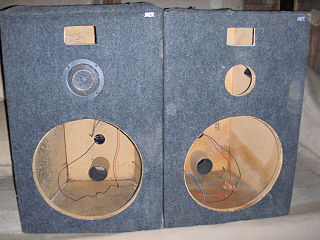
A subwoofer is a loudspeaker designed to reproduce low-pitched audio frequencies, known as bass and sub-bass, that are lower in frequency than those which can be (optimally) generated by a woofer. The typical frequency range that is covered by a subwoofer is about 20–200 Hz for consumer products, below 100 Hz for professional live sound, and below 80 Hz in THX-certified systems. Thus, one or more subwoofers are important for high-quality sound reproduction as they are responsible for the lowest two to three octaves of the ten octaves that are audible. This very low-frequency (VLF) range reproduces the natural fundamental tones of the bass drum, electric bass, double bass, grand piano, contrabassoon, tuba, in addition to thunder, gunshots, explosions, etc.

A loudspeaker is an electroacoustic transducer that converts an electrical audio signal into a corresponding sound. A speaker system, also often simply referred to as a speaker or loudspeaker, comprises one or more such speaker drivers, an enclosure, and electrical connections possibly including a crossover network. The speaker driver can be viewed as a linear motor attached to a diaphragm which couples that motor's movement to motion of air, that is, sound. An audio signal, typically from a microphone, recording, or radio broadcast, is amplified electronically to a power level capable of driving that motor in order to reproduce the sound corresponding to the original unamplified electronic signal. This is thus the opposite function to the microphone; indeed the dynamic speaker driver, by far the most common type, is a linear motor in the same basic configuration as the dynamic microphone which uses such a motor in reverse, as a generator.

Home cinema, also called home theaters or theater rooms, are home entertainment audio-visual systems that seek to reproduce a movie theater experience and mood using consumer electronics-grade video and audio equipment that is set up in a room or backyard of a private home. Some studies show that films are rated better and generate more intense emotions when watched in a movie theater, but convenience is a major appeal for home cinemas. In the 1980s, home cinemas typically consisted of a movie pre-recorded on a LaserDisc or VHS tape; a LaserDisc Player or VCR; and a heavy, bulky large-screen cathode ray tube TV set, although sometimes CRT projectors were used instead. In the 2000s, technological innovations in sound systems, video player equipment and TV screens and video projectors have changed the equipment used in home cinema set-ups and enabled home users to experience a higher-resolution screen image, improved sound quality and components that offer users more options. The development of Internet-based subscription services means that 2020s-era home theatre users do not have to commute to a video rental store as was common in the 1980s and 1990s.

Surround sound is a technique for enriching the fidelity and depth of sound reproduction by using multiple audio channels from speakers that surround the listener. Its first application was in movie theaters. Prior to surround sound, theater sound systems commonly had three screen channels of sound that played from three loudspeakers located in front of the audience. Surround sound adds one or more channels from loudspeakers to the side or behind the listener that are able to create the sensation of sound coming from any horizontal direction around the listener.
The low-frequency effects (LFE) channel is a band-limited audio track that is used for reproducing deep and intense low-frequency sounds in the 3–120 Hz frequency range.
Nakamichi Corp., Ltd. is a Japanese consumer electronics brand that originated in Japan and gained a name from the 1970s onwards for innovative and high quality audio cassette decks. Nakamichi is a subsidiary of Chinese holding company Nimble Holdings.
Dolby Pro Logic is a surround sound processing technology developed by Dolby Laboratories, designed to decode soundtracks encoded with Dolby Surround. The terms Dolby Stereo and LtRt are also used to describe soundtracks that are encoded using this technique.

Dolby Laboratories, Inc. is a British-American technology corporation specializing in audio noise reduction, audio encoding/compression, spatial audio, and HDR imaging. Dolby licenses its technologies to consumer electronics manufacturers.

JBL is an American audio equipment manufacturer headquartered in Los Angeles, California, United States. JBL serves the customer home and professional market. The professional market includes studios, installed/tour/portable sound, music production, DJ, cinema markets. The home market includes high-end home amplification/speakers/headphones as well as high-end car audio. JBL is owned by Harman International, itself a subsidiary of Samsung Electronics.
Altec Lansing, Inc. is an American audio electronics company founded in 1927. Their primary products are loudspeakers and associated audio electronics for professional, home, automotive and multimedia applications.

Computer speakers, or multimedia speakers, are speakers sold for use with computers, although usually capable of other audio uses, e.g. for an MP3 player. Most such speakers have an internal amplifier and consequently require a power source, which may be by a mains power supply often via an AC adapter, batteries, or a USB port. The signal input connector is often a 3.5 mm jack plug ; RCA connectors are sometimes used, and a USB port may supply both signal and power. Battery-powered wireless Bluetooth speakers require no connections at all. Most computers have speakers of low power and quality built in; when external speakers are connected they disable the built-in speakers. Altec Lansing claims to have created the computer speaker market in 1990.

DTS, Inc. is an American company, DTS company makes multichannel audio technologies for film and video. Based in Calabasas, California, the company introduced its DTS technology in 1993 as a competitor to Dolby Laboratories, incorporating DTS in the film Jurassic Park (1993). The DTS product is used in surround sound formats for both commercial/theatrical and consumer-grade applications. It was known as The Digital Experience until 1995. DTS licenses its technologies to consumer electronics manufacturers.

A loudspeaker enclosure or loudspeaker cabinet is an enclosure in which speaker drivers and associated electronic hardware, such as crossover circuits and, in some cases, power amplifiers, are mounted. Enclosures may range in design from simple, homemade DIY rectangular particleboard boxes to very complex, expensive computer-designed hi-fi cabinets that incorporate composite materials, internal baffles, horns, bass reflex ports and acoustic insulation. Loudspeaker enclosures range in size from small "bookshelf" speaker cabinets with 4-inch (10 cm) woofers and small tweeters designed for listening to music with a hi-fi system in a private home to huge, heavy subwoofer enclosures with multiple 18-inch (46 cm) or even 21-inch (53 cm) speakers in huge enclosures which are designed for use in stadium concert sound reinforcement systems for rock music concerts.

An audio/video receiver (AVR) is a consumer electronics component used in a home theater. Its purpose is to receive audio and video signals from a number of sources, and to process them and provide power amplifiers to drive loudspeakers and route the video to displays such as a television, monitor or video projector. Inputs may come from a satellite receiver, radio, DVD players, Blu-ray Disc players, VCRs or video game consoles, among others. The AVR source selection and settings such as volume, are typically set by a remote controller.

Studio monitors are loudspeakers in speaker enclosures specifically designed for professional audio production applications, such as recording studios, filmmaking, television studios, radio studios and project or home studios, where accurate audio reproduction is crucial. Among audio engineers, the term monitor implies that the speaker is designed to produce relatively flat (linear) phase and frequency responses. In other words, it exhibits minimal emphasis or de-emphasis of particular frequencies, the loudspeaker gives an accurate reproduction of the tonal qualities of the source audio, and there will be no relative phase shift of particular frequencies—meaning no distortion in sound-stage perspective for stereo recordings. Beyond stereo sound-stage requirements, a linear phase response helps impulse response remain true to source without encountering "smearing". An unqualified reference to a monitor often refers to a near-field design. This is a speaker small enough to sit on a stand or desk in proximity to the listener, so that most of the sound that the listener hears is coming directly from the speaker, rather than reflecting off walls and ceilings. Monitor speakers may include more than one type of driver or, for monitoring low-frequency sounds, such as bass drum, additional subwoofer cabinets may be used.
The fundamental principle of bass management in surround sound replay systems is that bass content in the incoming signal, irrespective of channel, should be directed only to loudspeakers capable of reproducing it, whether the latter are the main system loudspeakers or one or more subwoofers.

Polk Audio is an American manufacturer of audio products best known for its home and automobile speakers. The company also produces a wide range of other audio products, such as amplifiers and FM tuners. The company's headquarters are in San Diego, California. In 2006, it was bought by Directed Electronics. Polk Audio has also introduced smart speakers for Google Assistant and Amazon Alexa.

In sound recording and reproduction, audio mixing is the process of optimizing and combining multitrack recordings into a final mono, stereo or surround sound product. In the process of combining the separate tracks, their relative levels are adjusted and balanced and various processes such as equalization and compression are commonly applied to individual tracks, groups of tracks, and the overall mix. In stereo and surround sound mixing, the placement of the tracks within the stereo field are adjusted and balanced. Audio mixing techniques and approaches vary widely and have a significant influence on the final product.
Dolby Atmos is a surround sound technology developed by Dolby Laboratories. It expands on existing surround sound systems by adding height channels, allowing sounds to be interpreted as three-dimensional objects with neither horizontal nor vertical limitations. Following the release of Atmos for the cinema market, a variety of consumer technologies have been released under the Atmos brand, using in-ceiling and up-firing speakers.

Charles Emory Hughes II is an American inventor and audio engineer. He is known for his work on loudspeaker design, and the measurement of professional audio sound systems. Hughes first worked for Peavey Electronics designing loudspeakers and horns where he was granted a patent for the Quadratic-Throat Waveguide horn used in concert loudspeakers. He worked for Altec Lansing for two years as chief engineer for the pro audio division and was granted two more patents. In 2021, Hughes was hired by Biamp as principal engineer.















